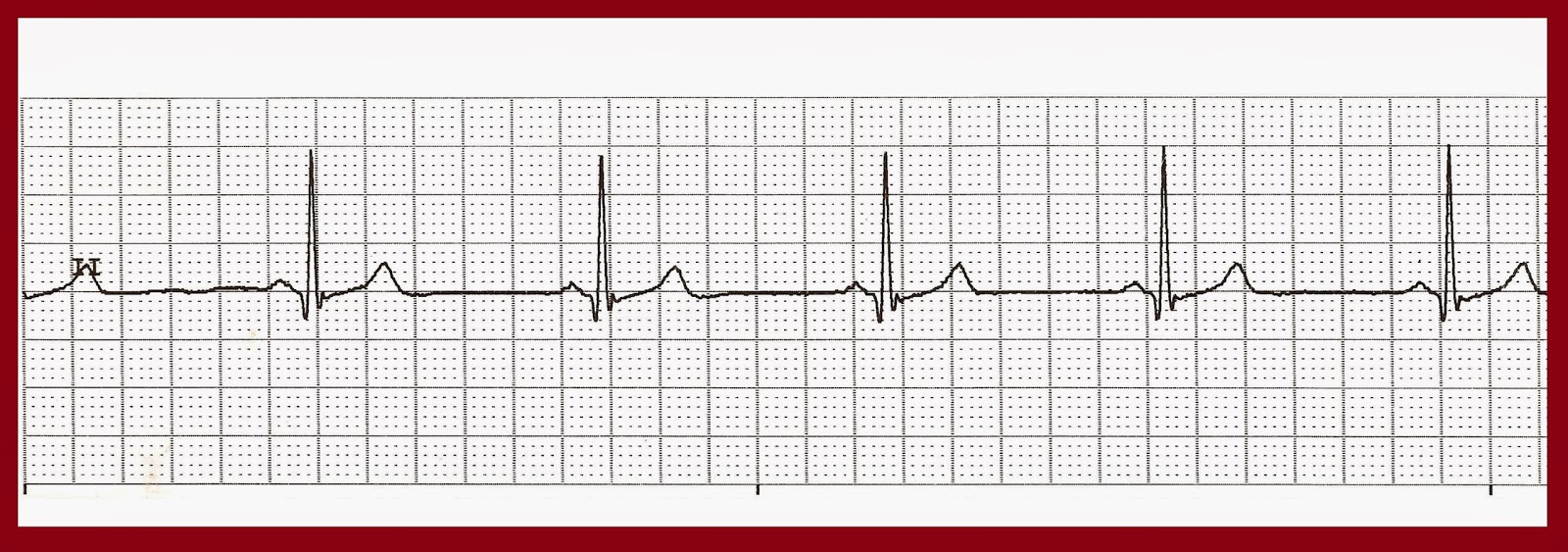Basic EKG Rhythm Test 17
Identify the following rhythms.
1.
a. Idioventricular rhythm
b. Complete heart block
c. Atrial fibrillation with slow ventricular response
d. Junctional rhythm
2.
a. Atrial paced
b. AV paced
c. Biventricular paced
d. Ventricular paced
3.

a. Polymorphic ventricular fibrillation
b. Torsades de pointes
c. Uniform ventricular tachycardia
d. Fine ventricular fibrillation
4.

a. Sinus bradycardia
b. Normal sinus rhythm
c. First degree block
d. 2nd degree heart block type II
5.
.png)
a. Atrial fibrillation
b. Sinus bradycardia
c. Accelerated idioventricular rhythm
d. Accelerated junctional rhythm
6.
7.
8.
9.
10.
11.
12.
13.
14.
15.
16.
17.
18.
19.
a. Atrial fibrillation with rapid ventricular paced
b. Atrial flutter with rapid ventricular response
c. Multifocal atrial tachycardia
d. Ventricular fibrillation
20.
21.
22.
23.
24.
25.
Do you want to try another Basic EKG Rhythm Test? Click here
Answers
01. a. Idioventricular rhythm
02. a. Atrial paced
03. b. Torsades depointes
04. c. First degree block
05. d. Accelerated junctional rhythm
06. d. Sinus bradycardia
07. d. Third degree block
08. b. Biventricular paced
09. c. 2nd degree AV block type II
10. a. Accelerated idioventricular rhythm
11. d. Agonal rhythm
12. c. Atrial fibrillation with slow ventricular response
13. c. Supraventricular tachycardia
14. a. Monomorphic ventricular tachycardia changing to ventricular fibrillation
15. d. Sinus rhythm with bigeminal PVCs
16. a. Atrial paced with PACs
17. b. NSR with multifocal PVCs
18. a. Sinus bradycardia with a sinus pause
19. b. Atrial flutter with rapid ventricular response
20. b. Coarse ventricular fibrillation
21. b. Junctional rhythm
22. b. NSR with trigeminal PACs
23. c. Wandering atrial pacemaker
24. b. Junctional tachycardia
25. c. Idioventricular rhythm
1.
a. Idioventricular rhythm
b. Complete heart block
c. Atrial fibrillation with slow ventricular response
d. Junctional rhythm
2.
a. Atrial paced
b. AV paced
c. Biventricular paced
d. Ventricular paced
3.

a. Polymorphic ventricular fibrillation
b. Torsades de pointes
c. Uniform ventricular tachycardia
d. Fine ventricular fibrillation
4.

a. Sinus bradycardia
b. Normal sinus rhythm
c. First degree block
d. 2nd degree heart block type II
5.
.png)
a. Atrial fibrillation
b. Sinus bradycardia
c. Accelerated idioventricular rhythm
d. Accelerated junctional rhythm
6.
a. Normal sinus rhythm
b. Accelerated idioventricular rhythm
c. Accelerated junctional rhythm
d. Sinus bradycardia
d. Sinus bradycardia
7.
a. First Degree block
b. Second degree block type I
c. Second degree block type II
d. Third degree block
d. Third degree block
8.
a. Atrial paced
b. Biventricular paced
c. Dual paced
d. Ventricular paced
d. Ventricular paced
9.
a. 1st degree block
b. 2nd degree AV block type I
c. 2nd degree AV block type II
d. Complete heart block
10.
a. Accelerated idioventricular rhythm
b. Accelerated junctional rhythm
c. Sinus rhythm
d. Atrial fibrillation
11.
a. Complete heart block
b. Junctional rhythm
c. Idioventricular rhythm
d. Agonal rhythm
d. Agonal rhythm
12.
a. Sinus arrhythmia with sinus bradycardia
b. Normal sinus rhythm with sinus arrest
c. Atrial fibrillation with slow ventricular response
d. Idioventricular rhythm
d. Idioventricular rhythm
13.
a. Accelerated idioventricular rhythm
b. Junctional tachycardia
c. Supraventricular tachycardia
d. Ventricular tachycardia
14.
a. Monomorphic ventricular tachycardia deteriorating into ventricular
fibrillation
b. Coarse ventricular fibrillation changing to fine
ventricular fibrillation
c. Torsades de pointes changing to ventricular fibrillation
d. Polymorphic ventricular tachycardia transitioning to atrial
fibrillation
15.
a. NSR with a pair of PACs
b. NSR with multifocal PVCs
c. NSR with unfocal PVCs
d. Sinus rhythm with bigeminal PVCs
d. Sinus rhythm with bigeminal PVCs
16.
a. Atrial paced with PACs
b. AV paced
c. Ventricular paced
d. Biventricular paced
d. Biventricular paced
17.
a. NSR with a pair of PACs
b. NSR with multifocal PVCs
c. NSR with unfocal PVCs
d. Sinus rhythm with bigeminal PVCs
d. Sinus rhythm with bigeminal PVCs
18.
a. Sinus bradycardia with a sinus pause
b. Sinus arrhythmia
c. Complete heart block
d. Sinus bradycardia with a dropped PAC
d. Sinus bradycardia with a dropped PAC
19.
a. Atrial fibrillation with rapid ventricular paced
b. Atrial flutter with rapid ventricular response
c. Multifocal atrial tachycardia
d. Ventricular fibrillation
20.
a. Monomorphic ventricular tachycardia
b. Coarse ventricular fibrillation
c. Torsades de pointes
d. Polymorphic ventricular tachycardia
21.
a. Normal sinus rhythm and a PVC
b. Junctional rhythm
c. Atrial fibrillation with slow ventricular response
d. Idioventricular rhythm
22.
a. NSR with trigeminal PJCs
b. NSR with trigeminal PACs
c. NSR with trigeminal PVCs
d. Sinus arrhythmia
23.
a. NSR with pauses
b. Sinus arrhythmia
c. Wandering atrial pacemaker
d. Atrial fibrillation
d. Atrial fibrillation
24.
a. Sinus tachycardia
b. Junctional tachycardia
c. Multifocal atrial tachycardia
d. Atrial fibrillation with rapid ventricular response
25.
a. Complete heart block
b. Junctional rhythm
c. Idioventricular rhythm
d. Agonal rhythmDo you want to try another Basic EKG Rhythm Test? Click here
Answers
01. a. Idioventricular rhythm
02. a. Atrial paced
03. b. Torsades depointes
04. c. First degree block
05. d. Accelerated junctional rhythm
06. d. Sinus bradycardia
07. d. Third degree block
08. b. Biventricular paced
09. c. 2nd degree AV block type II
10. a. Accelerated idioventricular rhythm
11. d. Agonal rhythm
12. c. Atrial fibrillation with slow ventricular response
13. c. Supraventricular tachycardia
14. a. Monomorphic ventricular tachycardia changing to ventricular fibrillation
15. d. Sinus rhythm with bigeminal PVCs
16. a. Atrial paced with PACs
17. b. NSR with multifocal PVCs
18. a. Sinus bradycardia with a sinus pause
19. b. Atrial flutter with rapid ventricular response
20. b. Coarse ventricular fibrillation
21. b. Junctional rhythm
22. b. NSR with trigeminal PACs
23. c. Wandering atrial pacemaker
24. b. Junctional tachycardia
25. c. Idioventricular rhythm

.png)





.jpg)

.jpg)



.png)

.jpg)




.jpg)




Comments
Post a Comment